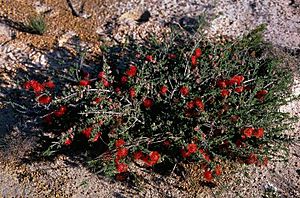Beaufortia bracteosa facts for kids
Quick facts for kids Beaufortia bracteosa |
|
|---|---|
 |
|
| Scientific classification | |
| Genus: |
Beaufortia (plant)
|
| Species: |
bracteosa
|
| Synonyms | |
|
Melaleuca glumacea Craven & R.D.Edwards |
|
Beaufortia bracteosa is a special plant that belongs to the myrtle family, called Myrtaceae. It's found only in the southwestern part of Western Australia, which means it's endemic there. This plant is a shrub that usually grows to about 1 meter (3 feet) tall. It has pretty red or maroon flowers and unique woody fruits.
Contents
What Does It Look Like?
Beaufortia bracteosa is a neat, compact shrub. It usually grows to be about 0.5 to 1 meter (1.6 to 3.3 feet) tall and about 0.75 meters (2.5 feet) wide. Its leaves grow in pairs, one across from the other. They are long and thin, about 2.5 to 4 millimeters (0.1 to 0.2 inches) long and 0.5 to 1.5 millimeters (0.02 to 0.06 inches) wide. The leaves are also glabrous, which means they are smooth and don't have any hairs.
Flowers and Fruit
The flowers of this plant grow in clusters at the ends of its branches. Each flower has 5 sepals (small leaf-like parts that protect the bud) and 5 petals. The most striking part is the 5 bundles of stamens. Stamens are the parts of a flower that produce pollen.
These stamens are a deep pink, red, or maroon color. They are joined together for about 1.5 to 4 millimeters (0.06 to 0.16 inches) of their length, forming a "claw" shape. This claw is hairy on one side. Each claw has about 5 or 6 stamens that spread out from the same point. These stamens are quite long, about 1 to 4 meters (3 to 13 feet) long.
Beaufortia bracteosa flowers for most of the year, but especially in spring and early summer. After the flowers, the plant produces woody fruits. These fruits are called capsules. They are about 7 to 11.5 millimeters (0.28 to 0.45 inches) long and 4.5 to 6 millimeters (0.18 to 0.24 inches) wide.
How It Got Its Name
Beaufortia bracteosa was first officially described in 1904 by a scientist named Ludwig Diels. He wrote about it in a book called Fragmenta Phytographiae Australiae occidentalis.
The second part of its name, bracteosa, comes from Latin words. The word bractea means "scale." The ending -osa means "having many (or large) bracts." Bracts are small, leaf-like structures often found near flowers. So, the name hints at a feature of the plant related to these bracts.
Where It Lives
This beaufortia plant likes to grow in sandy soils. Sometimes, these soils also have clay, gravel, or loam. It often grows over laterite or granite rock.
You can find Beaufortia bracteosa in several areas of Western Australia. These include places between Latham, Dumbleyung, the Wandoo National Park, and Jilbadji Nature Reserve. It grows in different biogeographic regions like the Avon Wheatbelt, Coolgardie, Esperance Plains, Geraldton Sandplains, Jarrah Forest, Mallee, and Swan Coastal Plain. It's an important part of the unique plant community called kwongan vegetation.
Is It Protected?
The Western Australian Government's Department of Parks and Wildlife has looked at Beaufortia bracteosa. They have classified it as "not threatened." This means that currently, there are enough of these plants in the wild, and they are not in danger of disappearing.
Images for kids


